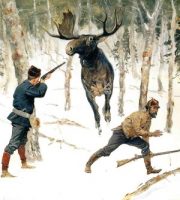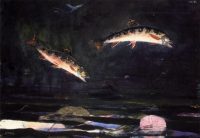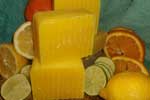
The Moose Hunt by Frederic Remington, ca. 1890
“Cedric”
What is the world is coming to? They took him under the white glare of 240 pairs of 10-foot fluorescent lights. It could have been revenge, but none of us knows. That’s the way it is here. They never tell us anything. So we have to piece things together.
We learn a little more each time a shift changes, via quick visits at the time clock. “Cedric” is the foremost topic of conversation right now, and the front-end workers summarize the known facts during afternoon lulls.
“Well, our robbers were pretty amateur compared to the ones that took Cedric the First,” said Brenda, as she scrubbed down her checkstand.
“You mean the one that belonged to that couple from Boulder?”
A once willowy girl from the East, and a solid, hunting store owner who had met and married 50 years before. The fragile elderly woman had said our elk mount reminded her of their moose head, something about the expression, no doubt. And the stretch mount which made him look long in the nose.
Elk heads are usually mounted to look upright, but our Cedric leaned out over the main flow of traffic in the front end. Most of us thought he looked just too immediate, with his mouth two feet above people’s heads.
The Boulder lady told us that even though “I came late to marriage and the West, I made up my mind to learn to love the things that made him happy.” She named his trophy “Cedric” with a long -e- and mourned when it was stolen. “We never saw it again,” she said, and her husband nodded his head and looked wistful, but not tragic. To gain a wife and lose a moose had not been terrible for him.
“But he said it was a moose, with a 12-foot span of antlers. How big was our elk, Barry?” said Ellen.
“Oh,” said the meat cutter judiciously as if everyone in the meat department had not settled the question down to tenths of inches, “that looked to be about a 4-foot rack, tip to tip.”
Will, the store manager, had arranged to borrow Cedric from a taxidermy studio to headline a Western promotion for the store. Three weeks beforehand, the mount arrived in the sagging arms of his owner and three men from the studio.
“The spike those guys hammered into the front wall wasn’t strong enough to hold him,” said Ellen. Cedric was a record 135-pound trophy mount. “They had to drill two holes into the metal on the back of the frame and fasten him with ‘super bolts.’”
“You should have seen those three men weave around under the spike trying to set that head in place,” said Irene, “The owner was afraid they were going to drop it any minute, and everyone else was giving directions.”
“The nose and antlers went up and down and the ears wobbled every which way. It was like trying to match a mural to a tack on a wall,” said Brenda.
The thieves who captured him were consummate planners, but they had to be near panic the Friday night Cedric came back down. There’s the broken glass in the top door window and the dent in the center door support where Cedric’s lowest points would have jutted out from their shoulders.
“He was at least five feet tall from the neck up because of the way they stretched him out to make the mount,” said Alan, the assistant manager. No matter how they turned him, he would have been an awkward package.
“How’s Will?” Brenda asked Alan. When Craig showed him the empty spot on the wall that morning, they said he went white and had to go up to his office to be alone.
“He says he wouldn’t have a stuffed goldfish in the store,” answered Alan. “He had to talk with the owner over the phone right after the police showed up. They’d never even heard some of the words that guy used.”
“Will got there before the police? He lives in Fairwood.”
“ Yeh, he almost drove his pickup into the store.”
“The police heard the owner talking?”
“I wouldn’t call it talking.”
“How many did it take to steal Cedric?”
The boxboys pondered about two seconds. “There had to be at least four.”
“Three to steady him while another guy unbolted him from the wall.”
“Jim said they heard the door buzz two times ,” said Chance.
There had to be at least one accomplice for a lookout and possibly another to hand up tools. A couple of the poachers could have skulked at a fast pace, in and out together.
The video rentals had kept Craig running from stocking the milk cooler to the camera bar until 2:30 a.m. He was helping out while Ed took his break and just wanted to put a few consecutive gallons of milk on the shelf before they began to warm.
The robbers must have spent nights patiently timing the night crew and charting a routine. They knew that Craig would work ten minutes before he checked the front, because most people don’t wait at the front for a checker to appear after 12:00 a.m. They come walking down the aisles ready to lecture the first person they see wearing an apron and a name tag. They don’t know the extra jobs each crew finds listed on the schedule every night.
“Notes! Notes! Notes! The bane of late-night work,” as Craig says.
You can’t talk reasonably with a note and explain that a busload of high-school basketball fans stopped by on their way out of town just before some telepathic message flashed through the collective subconscious of all those who did not attend Friday night games—saying, “Rent a movie. Stop by for a free cookie sample and cruise the aisles.”
Add in the overflowing-cart coupon shoppers, the regulars picking up a few small things, and the petty cigarette filchers, and when does anyone have time to finish a list of jobs, not to mention guard a six-point bull elk head?
It’s likely things don’t go any smoother for thieves than for the “poor working stiff.”
“They had to bring in stepladders,” said Pat, who works in produce, “and Ed and Craig found a bag of doughnuts on the front desk.” Evidence of one or more gang members having trouble staying on task. “The doughnuts were so oily the officers couldn’t even take fingerprints from them or the sack.” The boxboys snickered.
“They weren’t from our bakery!” said Ellen.
Ed said the snacking marauders were now a quart low in more ways than one, and he was surprised that Cedric hadn’t slipped out of their hands or they off the ladders.
You’d have thought it would have bothered the robbers to have Cedric eyeing them the whole time, but there’s no conscience in that type. To add to their difficulties, the front door of the store was blocked open as it is every February when its electric mechanism falters in -25-degree weather. This meant a constant flow of icy air numbed the faces and fingers of the burglars.
“What a circus!” said Irene.
“I almost feel sorry for them, whoever they are.”
“That’s only the tip of the iceberg of what goes on here after 2 a.m., said Ellen in an aside to Irene. She checked to be sure the assistant manager was out of hearing distance. “Ask Brenda about the night crew throwing fish over the aisle tops at each other. She came in one morning and the cereal and baking aisles smelled like a cannery. The new ones were mopping the floor like their lives depended on it.”
“They did. If he caught them, Alan would make them reface the entire store.”
“Wherever that head is, it’s probably in good condition,” said Pat. “If it had fallen on top of them, they wouldn’t have been able to move.”
“Wouldn’t their friends have helped them?” Barb asked.
“Are you kidding?” Elizabeth laughed. “There would have been a crash you could hear clear around the block. The ones that were still standing would have kicked up their heels and run.”
“That’s right,” interposed Irene. “They’re never going to find that thing for the same reason the thieves would leave their friends behind. They’d rather be shot than go to jail for helping to steal a bull elk head.”
One of the box-boys chimed in, “ Anything over 500 dollars is a felony.”
Chance walked up with a stack of large bags, shook his head as he filled a checkstand, and said with a pleasant grin, “The owner would prosecute to the max.”
It’s kind of sobering to imagine facing a prison population of armed robbers and frequent assault perpetrators in a hunting state, with the story that you were captured when you dropped and damaged a trophy head. . . . They’re right. Cedric is gone for good, lost forever to the Stuffed to the Gills (and Ears) Taxidermy Studio.
The crime might have had repercussions for the night crew’s jobs—except that they are a special breed. Which leads back to notes. Notes are inflexible. You cross off the job as done or you don’t go home. It’s amazing how easy it is for a fellow just finishing his day to list twice as much work as he can do into the next guy’s night.
This rests on the principle that if there isn’t enough time to finish a job, or if the day crew for one reason or another doesn’t want to cooperate with management, someone else will do it. The someone else is the night crew. They are the tie-up-loose-ends, fix-mistakes, do-the-rest-of-the-job people.
How does a night crew retain its dignity when something like this happens on their shift? We’ll never know for sure. They seldom give their opinions to any but fellow stockmen and when they do, it is with caution and reserve. They are outside and somewhat above the roiling foment of store gossip and intrigue, and prefer to stay there. Do they admire the nerve and ambition of the scoundrels? Possibly. Are they shaken by the successful incursion? This is not likely.
They stand alone, away from the world of props and promotions. Their part in grocery is essential. They get the product on the shelf or none of us makes a living. No mere instance of grand theft can affect their status. If they meet the bereaved owner of the elk head, they will commiserate in low, gentlemanly tones over the loss and might be led to talk a little about hunting and other great trophy heads they’ve seen.
It will be up to the day crew to pass final judgment on the event and to miss Cedric. He was a great topic of conversation and enlivened the daily routine by his arresting presence. The marauders now carry a double weight of guilt and suspicion.
A Cedric is an object of envy. Who knows how many walls he will grace, how many times he will change hands, what myths and legends will surround his history?
Unlike a diamond, Cedric will show wear and eventually lose value along with his hair. He may end up a prop again, like the old elk head Elizabeth keeps in her basement, something to dangle cat toys from for the amusement of manic kittens and languid tabbies. But until then he has, as the lady from Boulder perceived, a dignity befitting his name.
by Kathleen A. Curd Rau, Helena, Montana
Copyright © 1998, 2003 by Kathleen A. Curd Rau. All Rights Reserved.






 Jeanne Robertson
Jeanne Robertson Every Good Gift Montana
Every Good Gift Montana